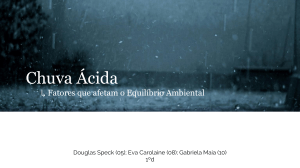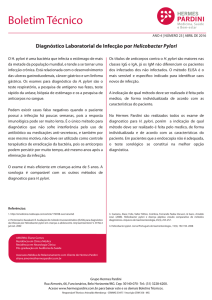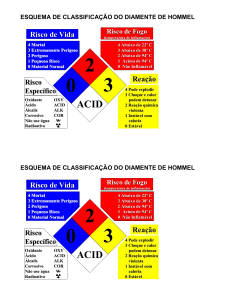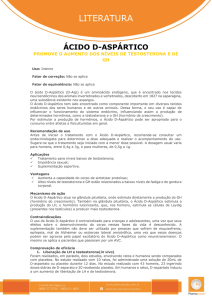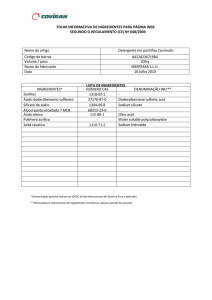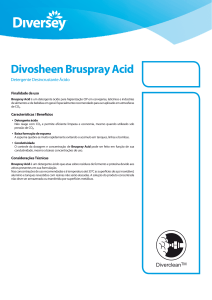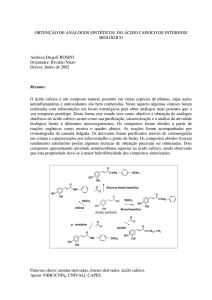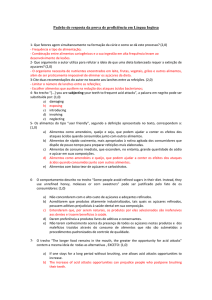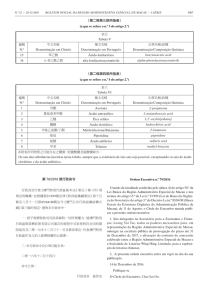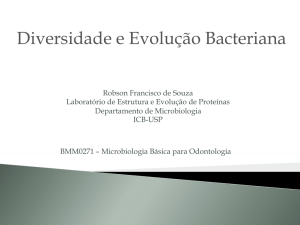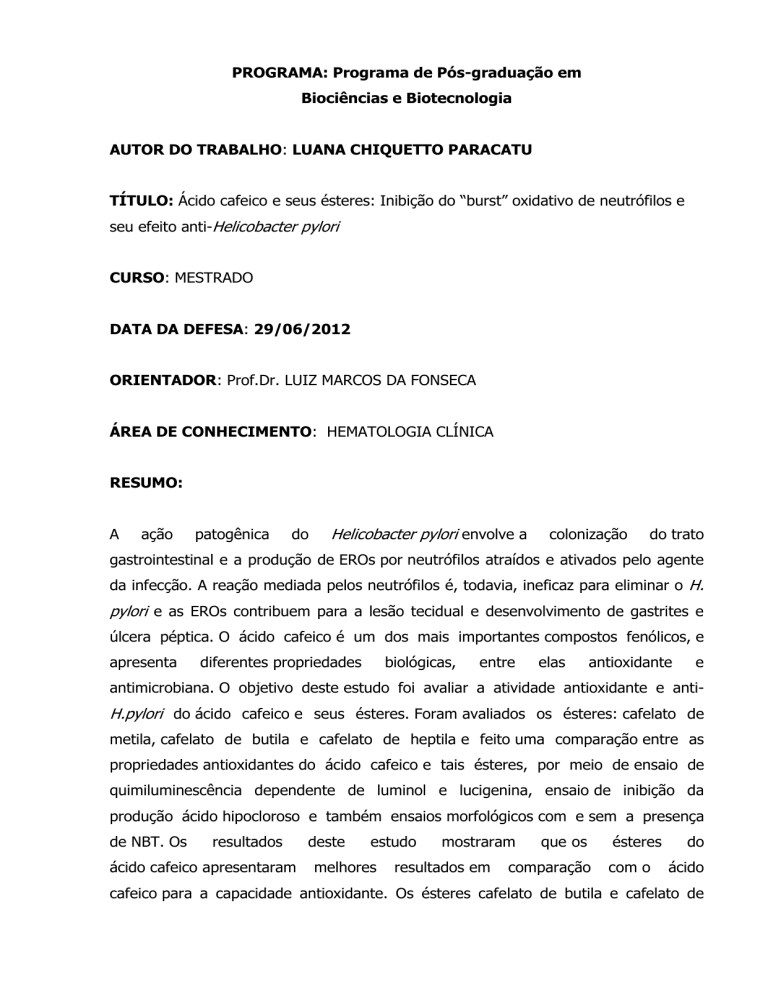
PROGRAMA: Programa de Pós-graduação em
Biociências e Biotecnologia
AUTOR DO TRABALHO: LUANA CHIQUETTO PARACATU
TÍTULO: Ácido cafeico e seus ésteres: Inibição do “burst” oxidativo de neutrófilos e
seu efeito anti-Helicobacter pylori
CURSO: MESTRADO
DATA DA DEFESA: 29/06/2012
ORIENTADOR: Prof.Dr. LUIZ MARCOS DA FONSECA
ÁREA DE CONHECIMENTO: HEMATOLOGIA CLÍNICA
RESUMO:
A
ação
patogênica
do
Helicobacter pylori envolve a
colonização
do trato
gastrointestinal e a produção de EROs por neutrófilos atraídos e ativados pelo agente
da infecção. A reação mediada pelos neutrófilos é, todavia, ineficaz para eliminar o H.
pylori e as EROs contribuem para a lesão tecidual e desenvolvimento de gastrites e
úlcera péptica. O ácido cafeico é um dos mais importantes compostos fenólicos, e
apresenta
diferentes propriedades
biológicas,
entre
elas
antioxidante
e
antimicrobiana. O objetivo deste estudo foi avaliar a atividade antioxidante e anti-
H.pylori do ácido cafeico e seus ésteres. Foram avaliados os ésteres: cafelato de
metila, cafelato de butila e cafelato de heptila e feito uma comparação entre as
propriedades antioxidantes do ácido cafeico e tais ésteres, por meio de ensaio de
quimiluminescência dependente de luminol e lucigenina, ensaio de inibição da
produção ácido hipocloroso e também ensaios morfológicos com e sem a presença
de NBT. Os
resultados
ácido cafeico apresentaram
deste
estudo
melhores
mostraram
resultados em
que os
comparação
ésteres
com o
do
ácido
cafeico para a capacidade antioxidante. Os ésteres cafelato de butila e cafelato de
heptila apresentaram os melhores resultados para a quimiluminescência dependente
de luminol induzido por H. pylori e zymozan opsonizado na concentração de 10 µM. O
efeito do ácido cafeico e seus ésteres, também foi estudado na produção de ácido
hipocloroso por
neutrófilos ativados. O
cafelato
de
heptila
novamente
provou ser melhor em apacidade antioxidante, levando a crer que lipofilicidade deste
composto e dos outros cafelatos, devido à sua estrutura molecular, foi a causa desta
melhor
atividade.
resultados foram
Na
avaliação
demonstrados
da
pelo
atividade
antibacteriana,
os
cafelato
de
cafelato
butila
e
melhores
de
heptila, apresentando ambos 100% de inibição do crescimento de H. pylori, na
concentração de 250 µg/mL. Muito provavelmente a maior lipofilicidade destes
compostos dada a estrutura lipídica do H. pylori é também um fator preponderante na
atividade antimicrobiana observada.
ABSTRACT:
The pathogenic action of Helicobacter pylori involves the colonization of the
gastrointestinal tract and ROS production by neutrophils attracted and activated by the
agent of infection. However, the reaction mediated PMN is ineffective to remove the
H. pylori and ROS contribute to tissue damage and development of gastritis and peptic
ulcer. Caffeic acid is one of most important phenolic compounds, and has different
biological properties including antioxidant and antimicrobial activities. The aim of this
study was to evaluate the antioxidant and anti-Helicobacter pylori activity of caffeic
acid and esters. Esters evaluated: caffeic acid methyl ester, caffeic acid butyl ester and
caffeic acid heptyl ester and a comparison between the antioxidant properties of
caffeic acid and these esters through luminol and lucigenin chemiluminescence assay
dependent, inhibition of production of hypochlorous acid assay, morphological tests
with and without the presence of NBT. The results of this study showed that the
esters of caffeic acid had better results in comparison with caffeic acid to their
antioxidant capacity. The caffeic acid heptyl ester showed the best results for the
luminol and lucigenin dependent chemiluminescence induced by H. pylori and / or
opsonized zymozan in the concentrations of 10 µM and 1 µM. The effect of caffeic acid
and esters, was also studied in inhibiting of production of hypochlorous acid by
neutrophils activated with PMA. The caffeic acid heptyl ester again proved to be better
at antioxidant activity, implying that the lipophilicity of this compound as well as
others caffeic acid esters, due to their molecular structure, was cause of this better
activity. In assessing the antibacterial activity, best results were shown by caffeic acid
butyl ester and caffeic acid heptyl ester, both with 100% inhibition of growth of H.
pylori in a concentration of 250 mg / mL. Most probably the higher lipophilicity of
these compounds given the lipid structure of the outer membrane of H. pylori is also a
major factor in the observed antimicrobial activity.
BANCA EXAMINADORA:
Prof.Dr. LUIZ MARCOS DA FONSECA
Profa.Dra. CIBELE BONACORSI
Prof.Dr. VALDECIR FARIAS XIMENES

